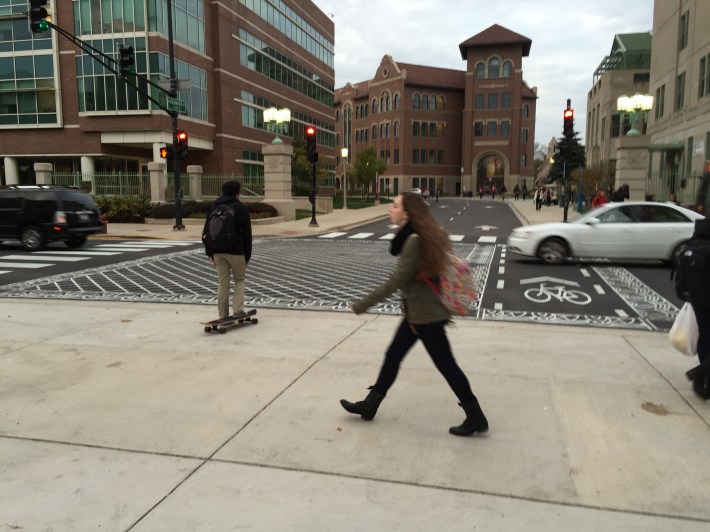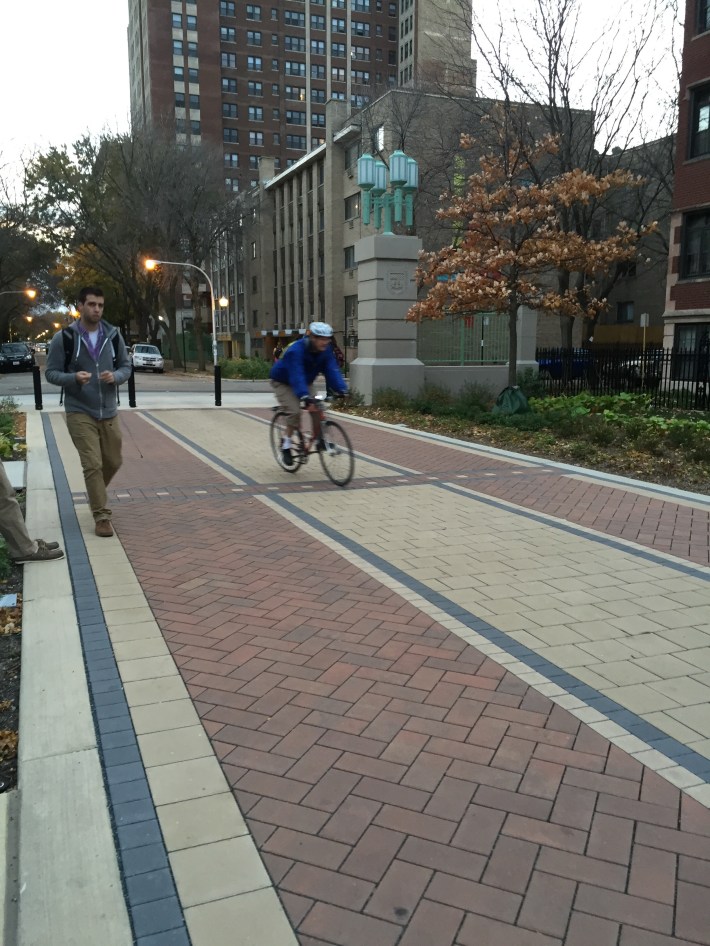
Loyola University Chicago recently expanded its Lake Shore campus south into the neighborhood, and took a different approach to connect the new buildings to its main campus across busy Sheridan Road. The university closed to car travel the entire 6300 block of North Kenmore Avenue, between Rosemont Avenue and Sheridan Road, and replaced the avenue with a wide brick shared-use path -- one of the first pedestrian-only streets on the far north side. The idea behind the new path was to allow a safer, car-free route between the southern portion of the school, which includes several dormitories and the new Institute of Environmental Sustainability building, and the main campus.
As Streetsblog reported earlier, some residents in the area were frustrated with the plan for two reasons, both closely associated with auto access. One issue was that several parking spaces would be eliminated in an area with a high demand for free parking, and another issue was that barring cars from Kenmore eliminated a short cut for far north-siders to take when Sheridan Road is congested.
Construction on this project started in 2013 when streets in the immediate area were closed entirely, and continued for over a year. In the meantime, cyclists and pedestrians alike had to take alternative routes using alleys or by biking the wrong way on parallel Winthrop Avenue. (The only other parallel street is the four-lane Sheridan Road speedway, where the city's ban on sidewalk cycling is strictly enforced.) The university bought Kenmore from the city for over $300,000, and spent over $3.5 million dollars to renovate the property. This pathway now includes a permeable brick surface, green space, and flower gardens to fill what a space that once was rows of parked cars.
I frequently travel through the area and was curious to see what others in the community thought of this project. After two different days of visiting the site, it seems that other residents and students agree that it's enhanced the area and created a safer way for them to reach the university.

It seems that most of the path's users are university students or staff, rather than neighborhood residents, although I did see several residents walking by with their dogs.
Elaina, an employee of Loyola University, commutes daily via bike from Lincoln Park. She said that she found this pathway to be a great asset on her commute. Although many other paths shared between bicyclists and pedestrians have resulted in conflicts, that doesn't appear to the case here. When asked if there was room for improvement, her answer was no: “I haven’t had any issues while using this pathway.”
De’Netria, a first year graduate student who's only lived in Chicago for four months, appreciates the new path, saying “I think it has been nice and tranquil since it has been built. It's easier for me to walk to class or work, especially with all the senseless traffic in the area.” Kelsey Plunk, who is also a first year student, said it made accessing the campus easier for her -- especially when she has evening classes, since it's well lit at night.
Several of the cyclists on the path seemed to be in a rush to beat the light across Sheridan. This could eventually lead to a collision, either with a pedestrian on the path or an automobile on Sheridan. Not many northbound cyclists were taking the pathway in the first place, though. Instead, 15 of the 22 cyclists I observed turned west onto Rosemont, perhaps to head west into Edgewater. Perhaps these cyclists are heading to destinations to the west, or if continuing north, want to avoid the university campus entirely. Although it's possible for a bicyclist to travel through the campus, there aren't many routes to the north besides Sheridan.
Once snow falls on the ground, it will be interesting to see how well Loyola University maintains this route. When more residents discover this new neighborhood asset, I suspect that more will choose to walk or ride down this pathway to connect to the lakefront trail to the south or Loyola Beach to the north.




